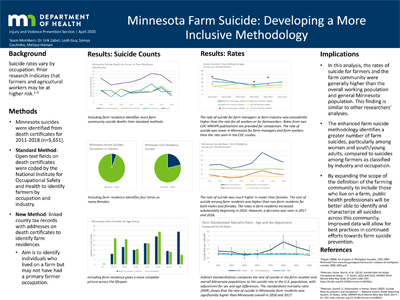Leah Guy
MPH, Community Health Promotion
Co-Authors:
Erik Zabel
Advisor:
Dr. Julie Sanem
Educational Objectives:
Differentiate between the standard NIOSH classifications of farmer by occupation and industry and this project’s new classification of farm residence. Compare rates of suicide among farm managers and workers in Minnesota to national rates of these same populations.
Keywords:
Suicide, Rural Health
Abstract
Suicide rates vary by occupation, and prior research indicates that farmers and agricultural workers may be at higher risk.
Minnesota suicides were identified from death certificates for 2011-2018 (n = 5,651). Text fields on death certificates were coded by the National Institute for Occupational Safety and Health to identify farmers by occupation and industry. Additionally, this project linked county tax records with addresses on death certificates to identify farm residences, identifying individuals who lived on a farm but may not have had a primary farmer occupation.
The farm residence classification identified twice as many farm suicides among youth and young adults (aged 10-24) and four times more females than standard methods. The primary lethal means of suicide among the farming community was firearm (66%), compared to the general Minnesota population where 46% of suicides from 2011-2018 were by firearm.
The rate of suicide for farm managers was consistently higher than the rate for all workers, but the rate of suicide for farm managers and farm workers was lower in Minnesota than national rates. Occupational rates were only calculated for males due to small numbers of females.
The age-adjusted rate of suicide for farm residents was higher than the rate for non-farm residents in every year from 2011-2018 and was significantly higher in 2016 and 2017.
By expanding the definition of the farming community to include farm residents, researchers will be better able to identify and characterize all suicides across this community, allowing for continued improvement in farm suicide prevention.

View Poster (PDF)
